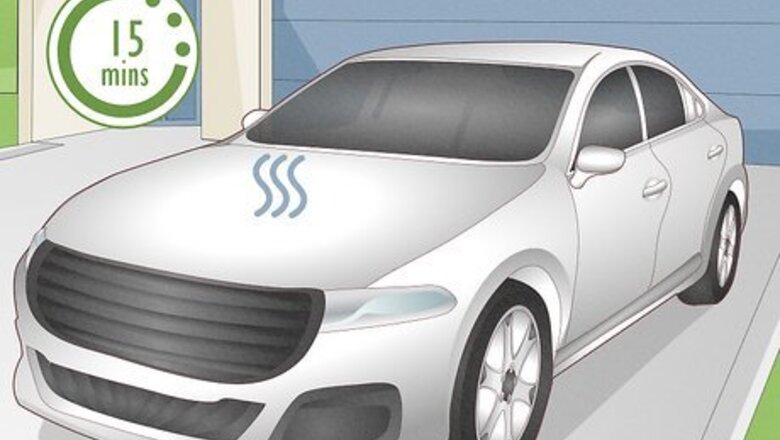
views
- Turn your engine off and let it cool down for 15 minutes, then pop the hood and locate the coolant reservoir near the engine.
- Uncap the coolant reservoir and use a funnel to add coolant to the reservoir up to the “MAX” or “FILL LINE” indicators on the side.
- Replace the coolant cap and let the car idle for 5 minutes while you check the pipes and connectors on the reservoir for leaks.
Adding Coolant to Your Car
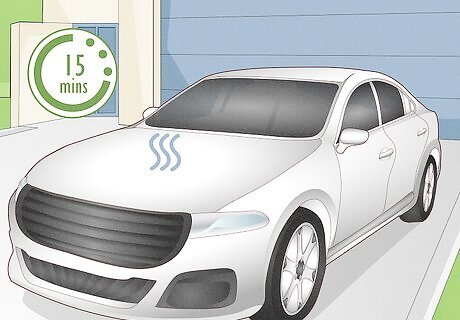
Park your car on a flat surface and let it cool for 15 minutes. If you can, park on level ground to get a more accurate gauge of your coolant levels. Then, let the engine cool down for 15-20 minutes. Engines can get incredibly hot to the touch, and if you’re lacking coolant, the danger of a burn is only increased as your engine runs even hotter. While you’re waiting, check your car’s owner’s manual to see if it specifies a coolant type. Most cars can take any general-purpose coolant, but some are a bit pickier.
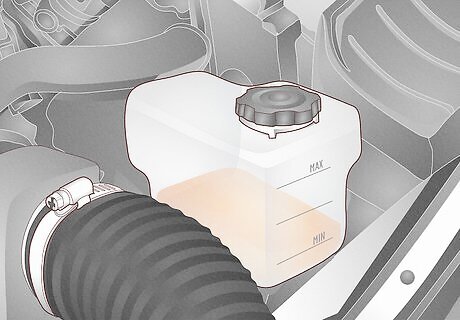
Pop the hood and locate your coolant reservoir. Open your car’s hood (often by pulling a lever by your driver’s seat) and take a look at your engine block to find the coolant reservoir. Often, it’s a white, semi-translucent tank near the engine. It’s sometimes labeled with “COOLANT,” a thermometer symbol, or just a warning not to touch it while it’s hot. If you can’t locate your coolant reservoir, find your radiator instead. This is the grate at the front of your car which has a metal cap where you’ll add the coolant. The coolant reservoir runs to your radiator, so it doesn’t really matter which you add the coolant to. That said, you’ll be able to add more coolant directly to the reservoir, which means you can go longer without topping up again.
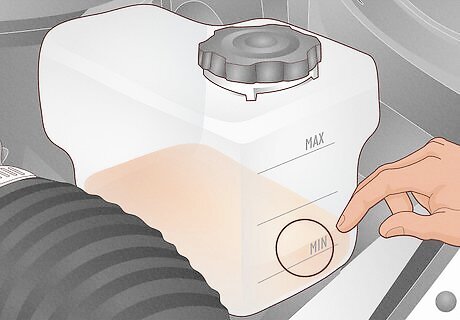
Check your coolant levels with the fill lines on the reservoir. Most reservoirs have labels on the side reading “MIN,” “MAX,” or, “FILL LINE,” which indicate the minimum amount of coolant you should have, the maximum amount, or to which level you’ll fill the reservoir, respectively. Compare the amount of coolant in your reservoir to these lines (the reservoir is semi-translucent for exactly this purpose). If your coolant is near the MIN line, or well beneath the FILL LINE, add more coolant immediately. If your coolant is at or near the MAX or FILL LINE, there’s no need to add more, but check back in a few weeks to keep an eye on it. There aren’t many situations in which your coolant is above the “MAX” line, unless you previously overfilled it. In which case, use a turkey baster to remove some.
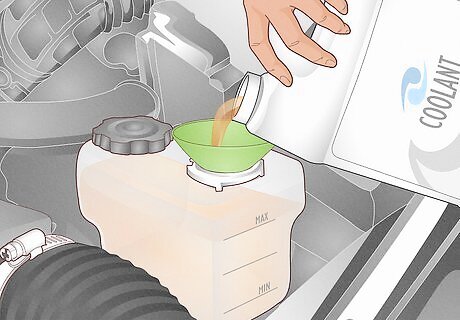
Remove the reservoir cap and add coolant to the fill line. Unscrew or pop off the cap to the reservoir (make sure it’s totally cooled off, first), then, for easier application, place a funnel in the opening. Carefully pour coolant into the reservoir until the level reaches just below the MAX or FILL LINE. Take care not to overfill it, which may cause damage to the reservoir. You may hear some hissing as the pressure releases. If you do, pause for moment before it dissipates, then slowly continue to remove the cap. If you’re adding coolant to the radiator instead, unscrew the radiator cap and pour coolant into the pipe until the coolant level sits just beneath the lip of the pipe’s opening, which indicates that the radiator is full.
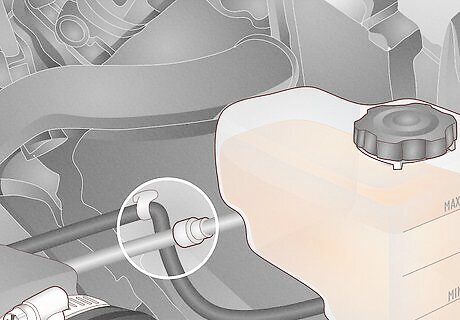
Turn on the engine and check for any coolant leaks. Let the engine run for about 5 minutes to let it take in new coolant. The coolant level in the reservoir may go down, but that’s normal. While the engine is running, examine the pipes and connections that lead to the reservoir, and take note of any apparent leaks. If you spot dripping liquid, take your car to a mechanic sometime in the next couple weeks to have it professionally examined.
When do you need to check or add coolant?
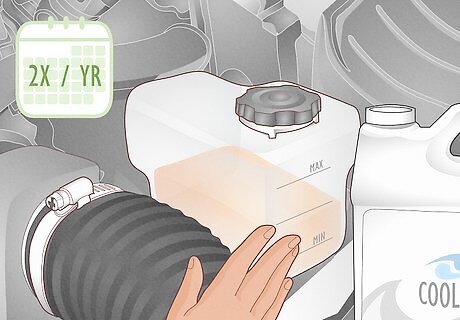
Check your coolant twice a year. If your engine is healthy and your car is running as usual, check your coolant once in the spring and once in the fall. That way, you can add or replace your coolant before the hottest and coldest times of the year, protecting your car against extreme temperatures. It helps to check your coolant every time you change your oil, since you’re already under the hood of your car.
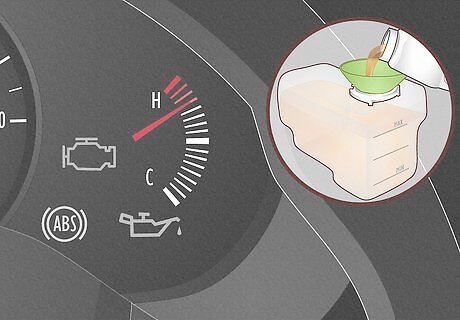
Add coolant if your car is running hot. Keep an eye on the temperature gauge on your dashboard, just behind the steering wheel and marked with a thermometer symbol. If the needle on the gauge points to red, you might either be lacking coolant, or your car’s cooling system may be faulty. Check the reservoir to see if the coolant is low. If there is coolant, but your car is running hot anyway, consult a mechanic immediately to diagnose the problem.
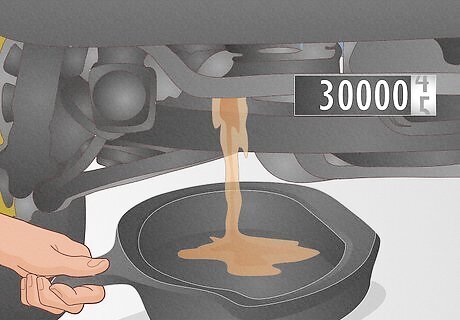
Replace your coolant every 30,000 miles. Old coolant becomes acidic and can start to corrode your engine block and your coolant system. Use a coolant flush kit to drain your coolant, or have a mechanic replace your coolant, every 30,000 miles you drive. This helps keep your car running efficiently, keeping the overall temperature in a healthy range.
Coolant vs. Antifreeze
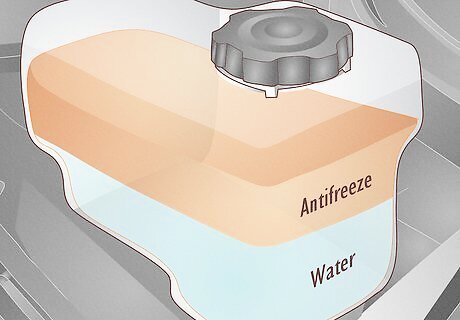
Coolant is often a 50/50 mixture of water and antifreeze. While the terms are often used interchangeably, they’re different things. Antifreeze is a solution that prevents other liquids from freezing. Coolant is a mixture of water and antifreeze—the water cools your engine, and the antifreeze keeps it from freezing in low temperatures. Antifreeze must be mixed with water before using it as a coolant. Many commercial antifreezes come premixed, in which case they’re labeled as “coolant.” Antifreeze has no particular application on its own, and in fact many experts advise against adding pure antifreeze to any part of a car, since it may corrode the internal mechanisms.













Comments
0 comment